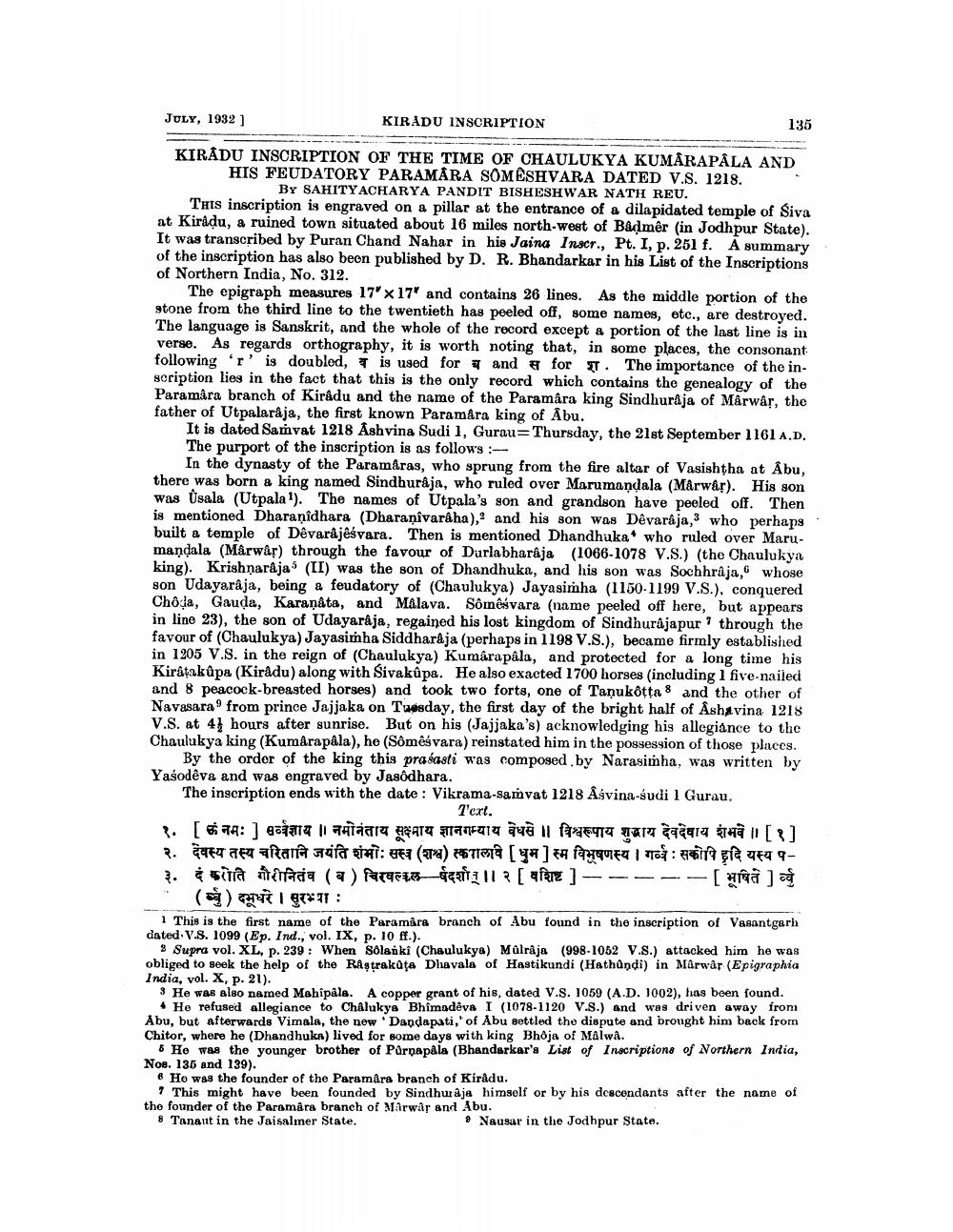________________
JULY, 1932 ]
KIRADU INSCRIPTION
135
KIRĀDU INSCRIPTION OF THE TIME OF CHAULUKYA KUMĀRAPALA AND HIS FEUDATORY PARAMÅRA SOMESHVARA DATED V.S. 1218.
BY SAHITYACHARYA PANDIT BISHESHWAR NATH REU. This inscription is engraved on a pillar at the entrance of a dilapidated temple of Siva at Kiradu, a ruined town situated about 16 miles north-west of Badmêr (in Jodhpur State). It was transcribed by Puran Chand Nahar in his Jaina Inscr., Pt. I, p. 251 f. A summary of the inscription has also been published by D. R. Bhandarkar in his List of the Inscriptions of Northern India, No. 312.
The epigraph measures 17" x 17" and contains 26 lines. As the middle portion of the stone from the third line to the twentieth has peeled off, some names, etc., are destroyed. The language is Sanskrit, and the whole of the record except a portion of the last line is in verse. As regards orthography, it is worth noting that, in some places, the consonant following 'r' is doubled, T is used for a and for T. The importance of the inscription lies in the fact that this is the only record which contains the genealogy of the Para mara branch of Kiradu and the name of the Paramâra king Sindhuraja of Mârwâr, the father of Utpalaraja, the first known Paramára king of Abu.
It is dated Samvat 1218 Ashvina Sudi 1, Gurau=Thursday, the 21st September 1161 A.D. The purport of the inscription is as follows:
In the dynasty of the Paramaras, who sprung from the fire altar of Vasishtha at Åbu, there was born a king named Sindhuråja, who ruled over Marumandala (Mârwar). His son was Usala (Utpala"). The names of Utpala's son and grandson have peeled off. Then is mentioned Dharanidhara (Dharanivaraha), and his son was Dêvarâja, 3 who perhaps built a temple of Dêvardjeśvara. Then is mentioned Dhandhuka. who ruled over Marumandala (Mârwâr) through the favour of Durlabharaja (1066-1078 V.S.) (the Chaulukya king). Krishnaraja“ (II) was the son of Dhandhuka, and his son was Sochhrâja, whose son Udayarâja, being a feudatory of (Chaulukya) Jayasimha (1150-1199 V.S.), conquered Choda, Gauda, Karanata, and Malava. Sômêsvara (name peeled off here, but appears in line 23), the son of Udayaraja, regained his lost kingdom of Sindhurajapur' through the favour of (Chaulukya) Jayasimha Siddharaja (perhaps in 1198 V.S.), became firmly established in 1205 V.S. in the reign of (Chaulukya) Kumarapala, and protected for a long time his Kirâtakûpa (Kirâdu) along with Sivaküpa. He also exacted 1700 horses (including 1 five-nailed and 8 peacock-breasted horses) and took two forts, one of Tanukotta 8 and the other of Navasara from prince Jajjaka on Tuesday, the first day of the bright half of Ashavina 1218 V.S. at 4 hours after sunrise. But on his (Jajjaka's) acknowledging his allegiance to the Chaulukya king (Kumarapala), he (Sômêsvara) reinstated him in the possession of those places.
By the order of the king this prasasti was composed by Narasimha, was written by Yaśodêva and was engraved by Jasôdhara. The inscription ends with the date : Vikrama-samvat 1218 Åývina-áudi 1 Gurau,
T'ext. 3. [RA: ) 14 Ilajara HATA amatu aya di faa44 tar d ig & [ ] २. देवस्य तस्य चरितानि जयंति शंभोः सव (शश्व) कालाव [धुम ] स्म विभूषणस्य । गर्व : सकोपि हृदि यस्य प2. sua teada (a) parasta ria 11 ? [ afere] --- - - [ ]
(*) Igraf: 1 This is the first name of the Paramâra branch of Abu found in the inscription of Vasantgarh dated. V.8. 1099 (Ep. Ind., vol. IX, p. 10 ff.).
3 Supra vol. XL, p. 239 : When Solanki (Chaulukya) Malraja (998-1062 V.S.) attacked him he was obliged to seek the help of the RAstrakata Dhavala of Hastikundi (Hathandi) in Marwår (Epigraphia India, vol. X, p. 21).
3 He was also named Mahipala. A copper grant of his, dated V.S. 1059 (A.D. 1002), has been found.
• He refused allegiance to Chalukya Bhimadeva I (1078-1120 V.S.) and was driven away from Abu, but afterwards Vimala, the new 'Dandapati, of Abu settled the dispute and brought him back from Chitor, where he (Dhandhuka) lived for some days with king Bhoja of MalwA.
6 He was the younger brother of Parpapala (Bhandarkar's List of Inscriptions of Northern India, Noe. 136 and 139).
8 Ho was the founder of the Paramårs branch of Kirådu.
7 This might have been founded by Sindhuraja himself or by his descendants after the name of the founder of the Paramâra branch of Marwar and Abu. 8 Tanaut in the Jaisalmer State.
Nausar in the Jodhpur State.




